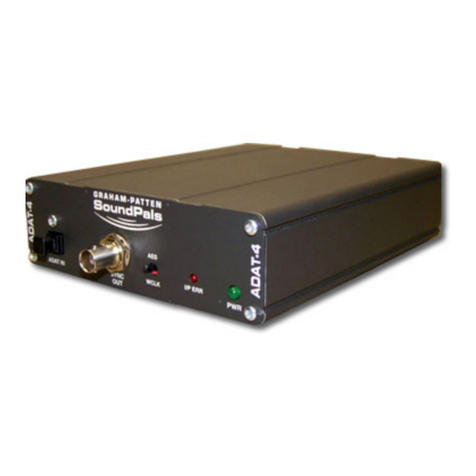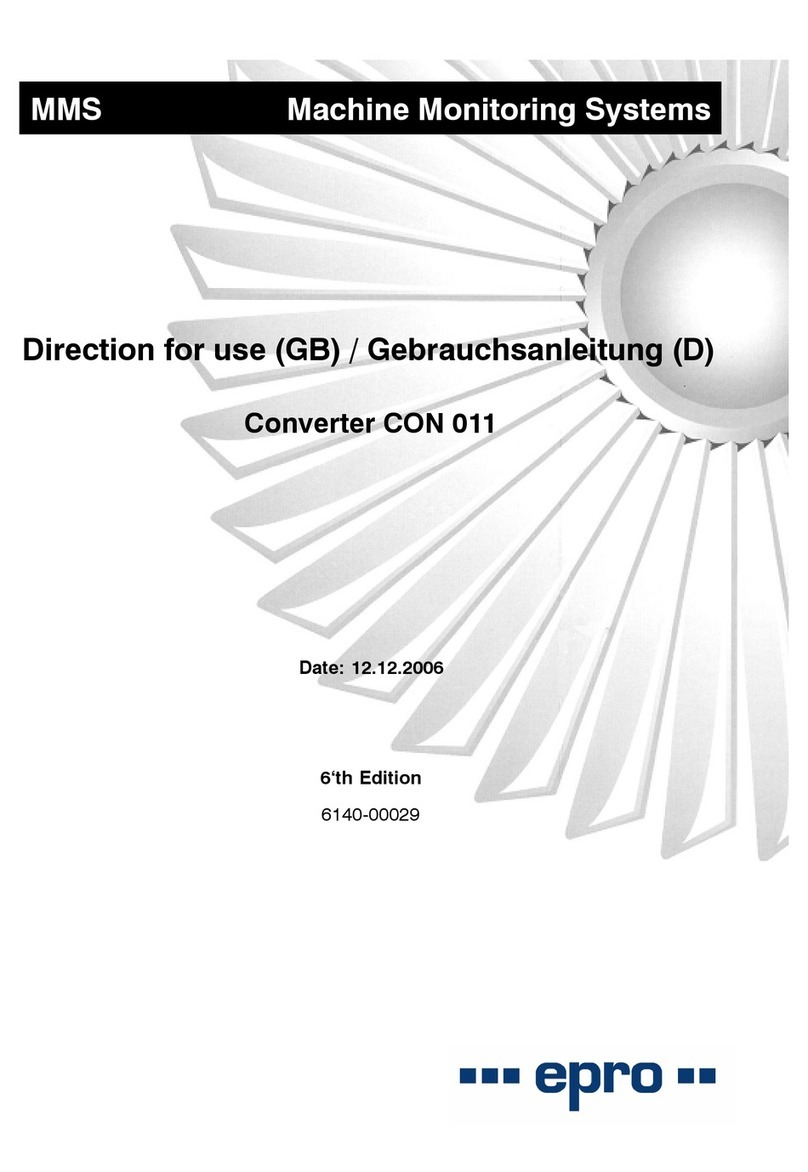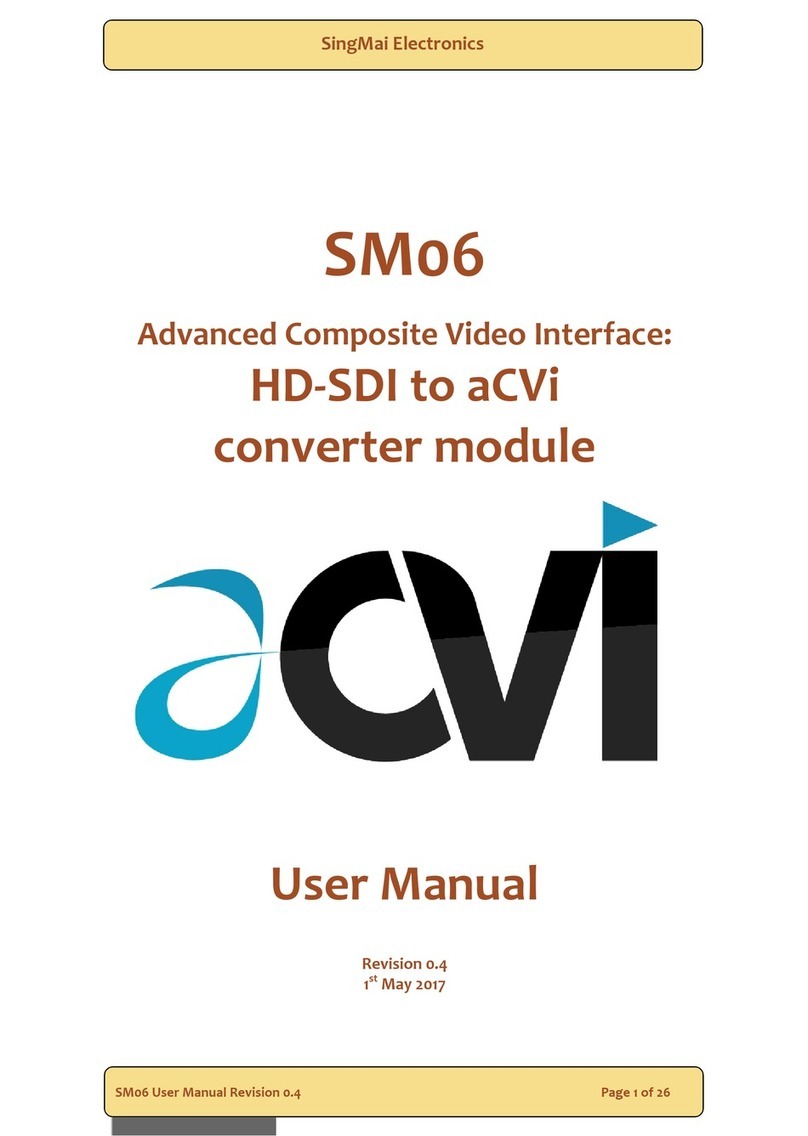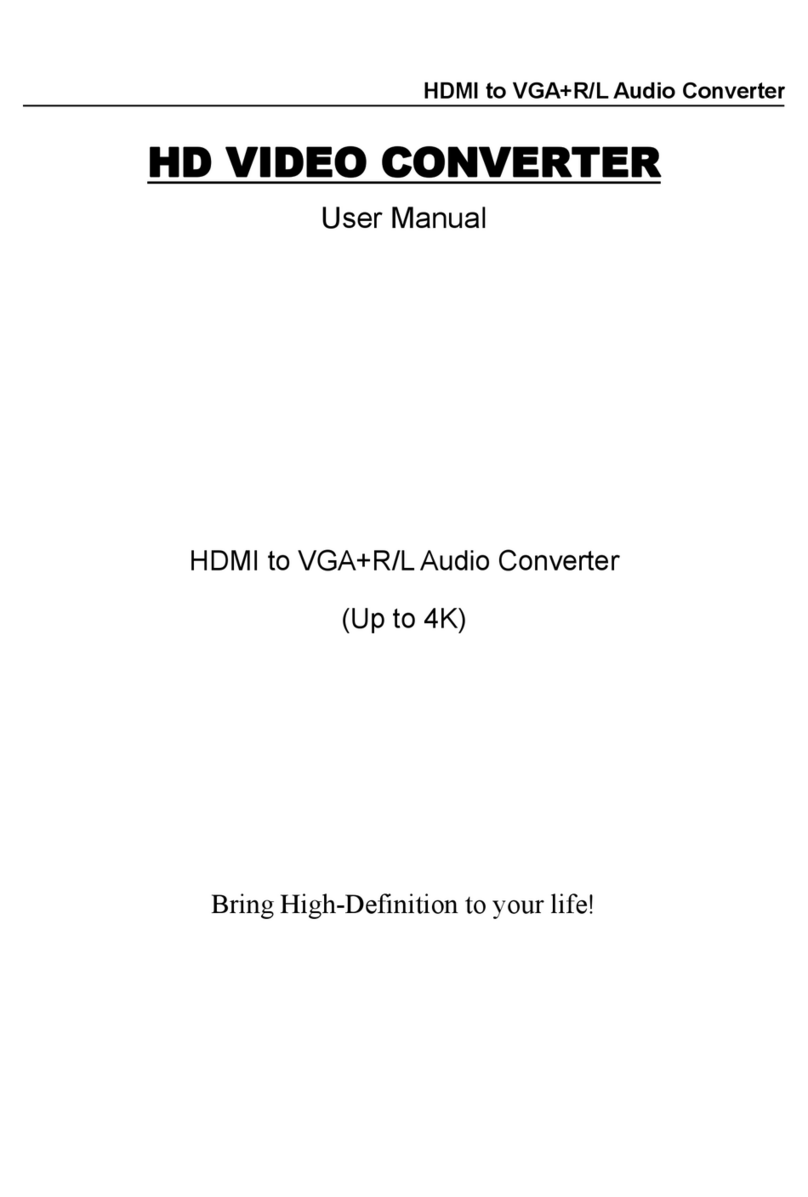Graham-Patten Avenue 6010 User manual

This data pack provides detailed installation, configuration and operation information for
the Model 6010 Four Channel 20-bit Audio Analog to Digital Converter (ADC)
module as part of the Avenue Signal Integration System.
The module information in this data pack is organized into the following sections:
• Module Overview
• Applications
• Installation
• Cabling
• Module Configuration and Control
°Front Panel Controls and Indicators
°Avenue PC Remote Control
°Avenue Touch Screen Remote Control
• Troubleshooting
• Software Updating
• Warranty and Factory Service
• Specifications
6010-1
Revision 3.1SW v1.0.0
Model 6010
Four Channel
20-Bit Audio ADC
Data Pack

MODULE OVERVIEW
The 6010 Four Channel 20-bit Analog to Digital Converter (ADC) converts four channels
of analog audio to two AES digital audio streams. Analog to digital conversion is
performed with 20-bit precision.
As shown in the block diagram below, four high impedance balanced analog audio inputs
enter the module on a high density 15-pin connector. The signals are buffered and passed
through gain adjustment circuitry before being converted to digital audio and sent to two
AES outputs (four copies of each) on rear BNC connectors. The ADC sample clocks may be
locked to an internal 48 kHz crystal controlled sample rate clock or locked to an external
AES3id reference from a BNC on the rear backplane.
Front panel indicators are provided for monitoring the external AES reference and the
four input channels of analog audio as well as power and CPU status.
Control of the module can be from one of the remote Avenue options or from the local
controls on the front of the module. Adjustments on the module include a rotary control to
set the analog input reference level and a set of switches to set the digital output
reference level. (Both of these reference levels determine the analog input gain.) The on-
board microprocessor communicates with the frame for remote control via the Avenue
System Control module if installed. Module ID (slot location, software version and board
revision) and status information can be monitored by the frame System Control module
and read using the optional interfaces available. Alarms can also be enabled if desired.
Power is derived from the ± 12 volt frame power. It is regulated to the required voltages
for the module by on-board regulators. The module is fused with resettable fuse devices.
If a fuse opens due to an overcurrent condition, the module will lose power. After pulling
the module, the fuse will reset automatically requiring no replacement fuse.
Model 6010 Four Channel 20-bit Audio ADC
Microcontroller
Crystal
Oscillator
ADC
ADC
AES
TX
AES
TX
Balanced
Analog
Inputs
Balanced
Analog
Inputs
AES
Outputs
AES
Outputs
Ref In Remote
Control
Gain
Adj.
Gain
Adj.
Gain
Adj.
Gain
Adj.
Level
Control Dip
Switches Status
Indicators
6010 Four Channel 20-bit Audio ADC Functional Block Diagram
6010-2

APPLICATIONS
Converting Analog VTR Audio Output to Digital
In the application shown below, a 6010 module converts the audio outputs of an analog
VTR to digital. Note that a 6030 Video Referenced AES/Word Clock Generator module
provides an AES clock reference for the 6010 module. In most video applications, it is
essential that AES sample clocks be locked to a video reference. Note also that the 6010
provides four copies of each AES output.
Analog Conversion from Video Routing Switcher to Feed Digital VTR
In this application, a 6010 module converts four channels of analog audio from a video
routing switcher to digital to feed a digital VTR. A 6030 Video Referenced AES/Word Clock
Generator module provides a video-locked AES reference for the 6010 module.
Model 6010 Four Channel 20-bit Audio ADC
6010-3
ANALOG VTR
6010 AUDIO ADC
6030 AES REF GEN
COLOR
BLACK
IN
AUDIO OUTPUTS
CH 2
CH 3
CH 4
AES REF OUT
CH 1 AES OUT
CH 1/2
(X4)
AES OUT
CH 3/4
(X4)
6010 Conversion of Analog VTR Audio Output to Digital
DIGITAL VTR
6010 AUDIO ADC
6030 AES REF GEN
COLOR
BLACK
IN
ANALOG AUDIO
FROM FACILITY
ROUTING SWITCHER
CH 2
CH 3
CH 4
AES REF OUT
CH 1/2
CH 3/4
CH 1
AUDIO
INPUTS
Converting Routing Switcher Analog Audio to Digital

Converting Audio Outputs of Two Independent 2-Track Analog Tape Recorders
Even though it is a four channel device, the 6010 utilizes two separate 2-channel A/D con-
verters. In this application, a 6010 module converts the audio outputs of two independent
2-track analog audio tape recorders to digital. Care should be exercised when connecting
the audio inputs to the 6010 to ensure that one machine is connected to inputs 1 and 2
and the other machine to inputs 3 and 4. This will ensure that the outputs of the two
machines will be paired correctly on the AES outputs of the 6010. Use of a 6030 module to
provide a video-locked AES reference for the 6010 is optional and is recommended in
video applications.
Driving a 6010 Using a Single-ended (unbalanced) Source
The 6010 has balanced transformerless inputs. The diagram below shows how to drive a
6010 using a single-ended (unbalanced) source.
Model 6010 Four Channel 20-bit Audio ADC
AUDIO TAPE RECORDER #1
AUDIO TAPE RECORDER #2
6010 AUDIO ADC
6030 AES REF GEN
COLOR
BLACK
IN
AUDIO OUTPUTS
AUDIO OUTPUTS
AUDIO INPUTS
AES REF OUT
CH 1
CH 1/LEFT
CH 1/LEFT
CH 2/RIGHT
CH 2/RIGHT
CH 2
CH 3
CH 4
AES OUT
ATR #1
(X4)
AES OUT
ATR #2
(X4)
ANALOG AUDIO SOURCE
6010 AUDIO ADC
GND
GND
SHIELDED CABLE _
+
UNBALANCED
AUDIO OUTPUT
BALANCED
AUDIO INPUT
(1 OF 4)
Audio Output Conversion of Two Independent 2-Track Analog Tape Recorders
6010 Driven by Single-Ended (unbalanced) Source
6010-4

Model 6010 Four Channel 20-bit Audio ADC
6010-5
INSTALLATION
Plug the 6010 module into any one of the ten slots in the frame and install the plastic
overlay provided onto the corresponding group of rear BNC connectors associated with the
module location. Note that the plastic overlay has an optional adhesive backing for
securing it to the frame. Use of the adhesive backing is only necessary if you would like
the location to be permanent and is not recommended if you need to change module
locations. This module may be hot-swapped (inserted or removed) without powering down
or disturbing performance of the other modules in the system.
CABLING
Refer to the backplane diagram of the module below for cabling instructions.
Connect an AES3id
reference input to the
Ref IN BNC if using an
external reference.
Connect output destina-
tions to the four sets of
AES Out 1/2 BNCs.
Connect the 15-pin high
density Audio In connector
to four analog audio sources.
Refer to the Audio In pinout
drawing below.
Connect output destina-
tions to the four sets of
AES Out 3/4 BNCs.
1
6
+
+
+
+
-
-
-
-
11
CH 2 CH 1
CH 3
CH 4
6010 Wiring to Frame
15-pin D Male Connector
Wiring Side-Male Plug
AUDIO IN PINOUT

MODULE CONFIGURATION AND CONTROL
The parameters for each Avenue module must be configured after installation. This can be
done remotely using one of the Avenue remote control options or locally using the module
front panel controls. Each module has a REMOTE/LOCAL switch on the front edge of
the circuit board which must first be set to the control mode you will be using.
The configuration parameter choices for the module will differ between Remote and
Local modes. In Remote mode, the choices are made through software and allow more
selections. The 6010 Parameter Table below summarizes and compares the various con-
figuration parameters that can be set remotely or locally and the default/factory settings.
If you are not using an remote control option, the module parameters must be configured
from the front panel switches. Parameters that have no front panel control will be set to a
default value. The Local switches are illustrated in the Front Panel Controls and
Indicators section following the 6010 Parameter Table.
Avenue module parameters can be configured and controlled remotely from one or both of
the remote control options, the Avenue Touch Screen or the Avenue PC Application. Once
the module parameters have been set remotely, the information is stored on the module
CPU. This allows the module be moved to a different cell in the frame at your discretion
without losing the stored information. Remote configuration will override whatever the
switch settings are on the front edge of the module.
For setting the parameters remotely using the Avenue PC option, refer to the Avenue PC
Remote Configuration section of this document.
For setting the parameters remotely using the Avenue Touch Screen option, refer to the
Avenue Touch Screen Remote Configuration section of this data pack following
Avenue PC.
Model 6010 Four Channel 20-bit Audio ADC
6010-6
Ch 1/2 Mode
Ch 3/4 Mode
CH 1-4 Digital Ref
Ch 1-4 Analog Ref
2-Channel
Stereo
Quad Tracking
-20 dBFS
-18 dBFS
-16DBFS
(Ch 1-4 Quad Tracking,
Ch 1/2 and/or 3/4 stereo pair or
individual channel adjustment)
-10dBu to +8dBu
(Ch 1-4 Quad Tracking,
Ch 1/2 and/or 3/4 stereo pair or
individual channel adjustment)
No Adjustment
AB Switch: 00 for -20 dBFS
01 for -18 dBFS
10 for -16 dBFS
Shaft Encoder:
-10dBu to +8dBu
Quad Tracking
N/A
N/A
CONTROL REMOTE
LOCAL DEFAULT VALUE
6010 Parameter Table

Front Panel Controls and Indicators
Each front edge indicator and switch setting is explained in the diagram below:
Model 6010 Four Channel 20-bit Audio ADC
6010-7
Remote/Local switch:
Set to the mode you
will be using.
EXT REF green LED:
ON indicates valid external
reference signal is present.
OFF indicates the external
reference is missing or invalid.
Pwr green LED:
Indicates the presence (ON) or
absence (OFF) of power (+5V).
CPU green LED:
OFF:
A power fault or halted CPU
ON:
A halted CPU
FAST BLINK:
CPU Run error
SLOW BLINK:
System OK. (If SPI control is
active from the main frame
System Control Module, all
Run indicators will be syn-
chronized.).
CH 1-CH4 green LEDs:
ON indicates analog input signal
peaks are reaching reference level.
OFF indicates the input signal
peaks are not reaching the
reference level.
REF -20/-18/-16
switch:
Set to the desired
digital reference
output level.
Select:
00 for -20 dBFS
01 for -18 dBFS
10 for -16 dBFS
LEVEL Adjustment:
Adjusts all four analog
inputs equally.

Avenue PC Remote Configuration
The Avenue PC remote control menus for this module are illustrated and explained in this
section. Refer to the 6010 Parameter Table shown earlier for a summary of available
parameters that can be set remotely through the menus illustrated. For more information
on using Avenue PC, refer to the Avenue PC Control Application Software data pack that
came with the option.
6010 Avenue PC Menus
The menus for the 6010 Audio ADC in the Avenue PC application allow you to set the
parameters for four channels of audio on this module. You may choose from three
operating modes, 2-Channel, Stereo or Quad Tracking.
You may set all four channels to 2-Channel mode, where each of the four audio channels
will be independent of each other. Adjustments may be made to each channel individually
and will not affect the other channels. Menu selections are provided for each channel as
shown in the following section.
You may set the four channels to Stereo mode, where Channels 1 and 2 and Channels 3
and 4 are stereo pairs. Adjustments made in the menus to one channel in the pair will
change the other channel. Channel 1 and 2 can be set to be independent (2-Channel)
while Channel 3 and 4 can be set to be a stereo pair if desired (or vice versa).
All four channels can be set to Quad Tracking where all channels will track together. If
parameters are changed in one channel, the other channels will track the change.
Selecting Quad Tracking in any one of the menus will change all channels to quad
tracking mode. A Quad Menu has been provided to allow easier adjusting and monitoring
of all four channels together.
Model 6010 Four Channel 20-bit Audio ADC
6010-8

In the Ch 1/2 Menu shown below, set the following parameters:
•Ch 1/2 Mode - set the operating modes for Channels 1 and 2.
Choose from 2-Channel (Ch 1 and 2 will be independent), Stereo (Ch 1/2 will be a
stereo pair) or Quad Tracking (Ch 1-4 will track together). Note that if you have
set Ch 3/4 in the next menu to Quad Tracking or the Quad On function is
enabled on the Quad Menu, this selection will default to Quad Tracking.
•Ch 1 Digital Ref - sets the Digital Output Reference level to match the studio
reference for channel 1 (in 2-Channel mode), Ch 1/2 if in Stereo mode or all four
channels together if in Quad Tracking mode.
•Ch 1 Analog Ref - sets the Analog Input Reference level from -10dBu to +8dBu (in
0.5dBu steps) for channel 1 only (in 2-Channel mode), Ch 1/2 if in Stereo mode or
all four channels if in Quad Tracking mode.
•Ch 2 Dig Ref - When Ch 1/2 Mode is set to 2-Channel, this will adjust Channel
2 Digital Output Reference level only. If Ch 1/2 Mode is set to Stereo, adjustment
will affect the stereo pair, or if set to Quad Tracking, adjustment will affect all
channels.
•Ch 2 Analog Ref - When Ch 1/2 Mode is set to 2-Channel, this will adjust
Channel 2 Analog Input Reference level only. If Ch 1/2 Mode is set to Stereo,
adjustment will affect the stereo pair, or if set to Quad Tracking, adjustment will
affect all channels.
In this menu, the following indicators are available:
•Sampling Frequency - will indicate what frequency the module is locking to,
either External Lock or 48kHz (internal).
•Clip Domain - will indicate where clipping will occur (in the analog or digital
domain).
•Ref Level - illuminates green when signal is reaching the Digital Output
Reference level chosen.
•D Clip1/2 - Black indicates signal is below digital clipping; Red indicates digital
signal is clipping. A grayed out box indicates that digital clipping cannot occur and
analog clipping will not be indicated.
Model 6010 Four Channel 20-bit Audio ADC
6010-9

In the Ch 3/4 Menu shown below, set the following parameters:
•Ch 3/4 Mode - set the operating modes for Channels 3 and 4.
Choose from 2-Channel (Ch 3 and 4 will be independent), Stereo (Ch 3/4 will be a
stereo pair) or Quad Tracking (Ch 1-4 will track together). Note that if you have
set Ch 1/2 in the previous menu to Quad Tracking or the Quad On function is
enabled on the Quad Menu, this selection will default to Quad Tracking.
•Ch 3 Digital Ref - sets the Digital Output Reference level for channel 3 (in
2-Channel mode). If Ch 3/4 Mode is set to Stereo, adjustment will affect the
stereo pair, or if set to Quad Tracking, adjustment will affect all channels.
•Ch 3 Analog Ref - sets the Analog Input Reference level from -10dBu to +8dBu (in
0.5dBu steps) for channel 3 only (in 2-Channel mode). If Ch 3/4 Mode is set to
Stereo, adjustment will affect the stereo pair, or if set to Quad Tracking, adjust-
ment will affect all channels.
•Ch 4 Dig Ref - When Ch 3/4 Mode is set to 2-Channel, this will adjust Channel
4 Digital Output Reference level only. If Ch 3/4 Mode is set to Stereo, adjustment
will affect the stereo pair, or if set to Quad Tracking, adjustment will affect all
channels.
•Ch 4 Analog Ref - When Ch 3/4 Mode is set to 2-Channel, this will adjust
Channel 4 Analog Input Reference level only. If Ch 3/4 Mode is set to Stereo,
adjustment will affect the stereo pair, or if set to Quad Tracking, adjustment will
affect all channels.
Refer to the Sampling Frequency, Clip Domain, Ref Level and D Clip indicator
explanations in the previous menu.
Model 6010 Four Channel 20-bit Audio ADC
6010-10

The Quad Menu shown below has been provided to allow adjusting and monitoring all
four channels at the same time when in Quad Tracking mode. Set the parameters as
follows:
•Channel Mode - Click in the Quad On box to enable quad tracking simultane-
ously for all four channels. Note that Quad Tracking can also be enabled in any
of the previous Channel mode menus.
•Digital Ref - set all four channels for the digital output reference to match your
studio reference.
•Analog Ref - adjusts the Analog input reference level of all four channels to
-10dBu to +8dBu (in 0.5dBu steps).
NOTE: Digital and Analog Ref settings above will only be active when Quad On is
checked.
The following indicators are available in the menu below:
•Sampling Frequency - will indicate what frequency the module is locking to,
either External Lock or 48kHz (internal).
•D Clip 1-4 - Black indicates signal is below digital clipping; Red indicates digital
signal is clipping. A grayed out box indicates that digital clipping cannot occur and
analog clipping will not be indicated.
•Ref Lvl - will illuminate green when each channel is reaching the digital output
reference level chosen.
•Clip Domain - will indicate where clipping will occur (Analog or Digital domain).
6010-11
Model 6010 Four Channel 20-bit Audio ADC

Avenue Touch Screen Remote Configuration
Avenue Touch Screen remote control menus for this module are illustrated and explained
below. Refer to the 6010 Parameter Table shown previously for a summary of available
parameters that can be set remotely through the menus illustrated. For more information
on using Avenue Touch Screen, refer to the Avenue Touch Screen data pack that came with
the option.
6010 Avenue Touch Screen Menus
In the Ch 1 Menu shown below, set the following parameters:
•Ch 1/2 Mode - set the operating modes for Channels 1 and 2.
Choose from 2-Channel (Ch 1 and 2 will be independent), Stereo (Ch 1/2 will be a
stereo pair) or Quad Tracking (Ch 1-4 will track together). Note that if you have
set Ch 3/4 to Quad Tracking or the Quad On function is enabled on the Quad
Menu, this selection will default to Quad Tracking.
•Ch 1 Digital Ref - sets the Digital Output Reference level to match the studio
reference for channel 1 (in 2-Channel mode), Ch 1/2 if in Stereo mode or all four
channels together if in Quad Tracking mode.
•Ch 1 Analog Ref - sets the Analog Input Reference level from -10dBu to +8dBu (in
0.5dBu steps) for channel 1 only (in 2-Channel mode), Ch 1/2 if in Stereo mode or
all four channels if in Quad Tracking mode.
In all channel menus, the following indicators are available:
•Sampling Frequency - will indicate what frequency the module is locking to,
either External Lock or 48kHz (internal).
•Clip Domain - will indicate where clipping will occur (in the analog or digital
domain).
•Ref Level - illuminates green when signal is reaching the Digital Output
Reference level chosen.
•D Clip1 - Black indicates signal is below digital clipping; Red indicates digital
signal is clipping. A grayed out box indicates that digital clipping cannot occur and
analog clipping will not be indicated.
Model 6010 Four Channel 20-bit Audio ADC
6010-12

In the Ch 2 Menu shown below, set the following parameters:
•Ch 1/2 Mode - set the operating modes for Channels 1 and 2.
Choose from 2-Channel (Ch 1 and 2 will be independent), Stereo (Ch 1/2 will be a
stereo pair) or Quad Tracking (Ch 1-4 will track together). Note that if you have
set Ch 3/4 to Quad Tracking or the Quad On function is enabled on the Quad
Menu, this selection will default to Quad Tracking.
•Ch 2 Dig Ref - When Ch 1/2 Mode is set to 2-Channel, this will adjust Channel
2 Digital Output Reference level only. If Ch 1/2 Mode is set to Stereo, adjustment
will affect the stereo pair, or if set to Quad Tracking, adjustment will affect all
channels.
•Ch 2 Analog Ref - When Ch 1/2 Mode is set to 2-Channel, this will adjust
Channel 2 Analog Input Reference level only. If Ch 1/2 Mode is set to Stereo,
adjustment will affect the stereo pair, or if set to Quad Tracking, adjustment will
affect all channels.
In this menu, the indicator descriptions are identical to Channel 1 on the previous page.
Model 6010 Four Channel 20-bit Audio ADC
6010-13

In the Ch 3 Menu shown below, set the following parameters:
•Ch 3/4 Mode - set the operating modes for Channels 3 and 4.
Choose from 2-Channel (Ch 3 and 4 will be independent), Stereo (Ch 3/4 will be a
stereo pair) or Quad Tracking (Ch 1-4 will track together). Note that if you have
set Ch 1/2 to Quad Tracking or the Quad On function is enabled on the Quad
Menu, this selection will default to Quad Tracking.
•Ch 3 Digital Ref - sets the Digital Output Reference level for Channel 3 (in
2-Channel mode). If Ch 3/4 Mode is set to Stereo, adjustment will affect the
stereo pair, or if set to Quad Tracking, adjustment will affect all channels.
•Ch 3 Analog Ref - sets the Analog Input Reference level from -10dBu to +8dBu (in
0.5dBu steps) for channel 3 only (in 2-Channel mode). If Ch 3/4 Mode is set to
Stereo, adjustment will affect the stereo pair, or if set to Quad Tracking, adjust-
ment will affect all channels.
Refer to the Sampling Frequency, Clip Domain, Ref Level and D Clip indicator
descriptions in the Channel 1 menu.
Model 6010 Four Channel 20-bit Audio ADC
6010-14

In the Ch 4 Menu shown below, set the following parameters:
•Ch 3/4 Mode - set the operating modes for Channels 3 and 4.
Choose from 2-Channel (Ch 3 and 4 will be independent), Stereo (Ch 3/4 will be a
stereo pair) or Quad Tracking (Ch 1-4 will track together). Note that if you have
set Ch 1/2 to Quad Tracking or the Quad On function is enabled on the Quad
Menu, this selection will default to Quad Tracking.
•Ch 4 Dig Ref - When Ch 3/4 Mode is set to 2-Channel, this will adjust Channel
4 Digital Output Reference level only. If Ch 3/4 Mode is set to Stereo, adjustment
will affect the stereo pair, or if set to Quad Tracking, adjustment will affect all
channels.
•Ch 4 Analog Ref - When Ch 3/4 Mode is set to 2-Channel, this will adjust
Channel 4 Analog Input Reference level only. If Ch 3/4 Mode is set to Stereo,
adjustment will affect the stereo pair, or if set to Quad Tracking, adjustment will
affect all channels.
Refer to the Sampling Frequency, Clip Domain, Ref Level and D Clip indicator
descriptions in the Channel 1 menu.
Model 6010 Four Channel 20-bit Audio ADC
6010-15

The Quad Menu shown below has been provided to allow adjusting and monitoring all
four channels at the same time when in Quad Tracking mode. Set the parameters as
follows:
•Channel Mode - Click in the Quad On box to enable quad tracking simultane-
ously for all four channels. Note that Quad Tracking can also be enabled in any
of the previous Channel mode menus.
•Digital Ref - set all four channels for the digital output reference to match your
studio reference.
•Analog Ref - adjusts the Analog input reference level of all four channels to
-10dBu to +8dBu (in 0.5dBu steps).
NOTE: Digital and Analog Ref settings above will only be active when Quad On is
checked.
The following indicators are available in the menu below:
•Sampling Frequency - will indicate what frequency the module is locking to,
either External Lock or 48kHz (internal).
•D Clip 1-4 - Black indicates signal is below digital clipping; Red indicates digital
signal is clipping. A grayed out box indicates that digital clipping cannot occur and
analog clipping will not be indicated.
•Ref Lvl - will illuminate green when each channel is reaching the digital output
reference level chosen.
•Clip Domain - will indicate where clipping will occur (Analog or Digital domain).
Model 6010 Four Channel 20-bit Audio ADC
6010-16

TROUBLESHOOTING
To aid in troubleshooting, signal reference levels and presence, power and CPU status can
be easily monitored from the front panel of this module using the indicators explained in
the previous section.
If using the Remote mode, the following status items can be monitored using the Avenue
Touch Screen Control Panel or PC Application:
• External reference present and valid
• Channels 1-4 analog inputs reaching reference levels
• Power status
• Slot ID, Software Version and Board Revision
Refer to the overall troubleshooting tips given below for the 6010 module:
No status lights are lit on front panel:
• Check that frame power is present (green LED{s} on frame power supplies).
• Check that module is firmly seated in frame. Try removing it and plugging
it in again.
Can’t control module:
• Check status of CPU Run red LED. Should be blinking slowly and in
unison with other modules if System Control module is present. If not, try
removing it and plugging it in again.
• System Control module may not be working properly if installed.
No AES signal out of module:
• Check cabling to input of module.
No Ext Ref indication:
•Check for presence and validity of external reference input signal if
required. (6010 will default to 48kHz internally.)
You may also refer to the technical support section of the Ensemble or Graham-Patten
web sites for the latest information on your equipment at the URLs below:
http://www.ensembledesigns.com/support
http://www.gpsys.com
SOFTWARE UPDATING
Software upgrades for each module can be downloaded remotely if the optional System
Control module is installed. These can be downloaded onto your PC and then Avenue PC
will distribute the update to the individual module. (Refer to the Avenue PC documenta-
tion for more information) Periodically, updates will be posted on our web site. If you do
not have the required System Control Module and Avenue PC, modules can be sent back
to the factory for software upgrades.
Model 6010 Four Channel 20-bit Audio ADC
6010-17

WARRANTY AND FACTORY SERVICE
Warranty
This Module is covered by a five year limited warranty, as stated in the main Preface of
this manual. If you require service (under warranty or not), please contact Ensemble
Designs or Graham-Patten Systems and ask for customer service before you return the
unit. This will allow the service technician to provide any other suggestions for identifying
the problem and recommend possible solutions.
Factory Service
If you return equipment for repair, please get a Return Material Authorization Number
(RMA) from the factory first.
Ship the product and a written description of the problem to:
Ensemble Designs, Inc.
Attention: Customer Service RMA #####
870 Gold Flat Rd.
Nevada City, CA. 95959 USA
(530) 478-1830
Fax: (530) 478-1832
http://www.ensembledesigns.com
Be sure to put your RMA number on the outside of the box.
OR
Graham-Patten Systems, Inc.
13366 Grass Valley Avenue
Grass Valley, CA 95945
(800) 422-6662 or (530) 273-8412
Fax: (530) 273-7458
http://www.gpsys.com
Model 6010 Four Channel 20-bit Audio ADC
6010-18

SPECIFICATIONS
6010 Four Channel 20-bit Audio ADC
Analog Input Z: >15k ohms, balanced, tranformerless
CMRR: >60dB, 20Hz - 10kHz
Analog Input
Reference Level: -10dBu to +8dBu
Digital Output
Reference Level: -16, -18, -20dBFS
AES3id reference
input: 1 volt p-p, terminated in 75 ohms
AES outputs: 1 volt p-p, 75 ohm source terminated
Sample Rate: 48kHz or External 30-50kHz
Frequency Response: +0/-0.1dB, 20Hz - 20kHz
Crosstalk: <-84dB, 20Hz - 20kHz
Dynamic range: 95dB
Due to ongoing product development, all specifications subject to change.
Model 6010 Four Channel 20-bit Audio ADC
6010-19
Table of contents
Other Graham-Patten Media Converter manuals
Popular Media Converter manuals by other brands
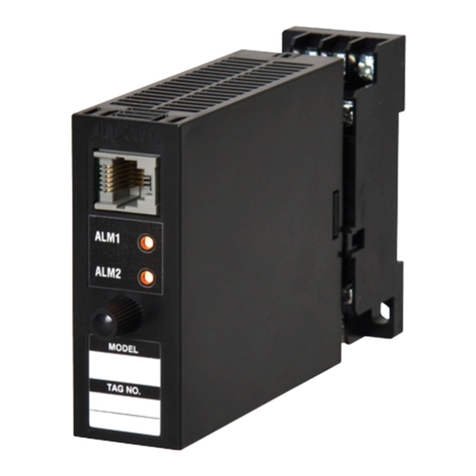
YOKOGAWA
YOKOGAWA JUXTA VJR6 user manual
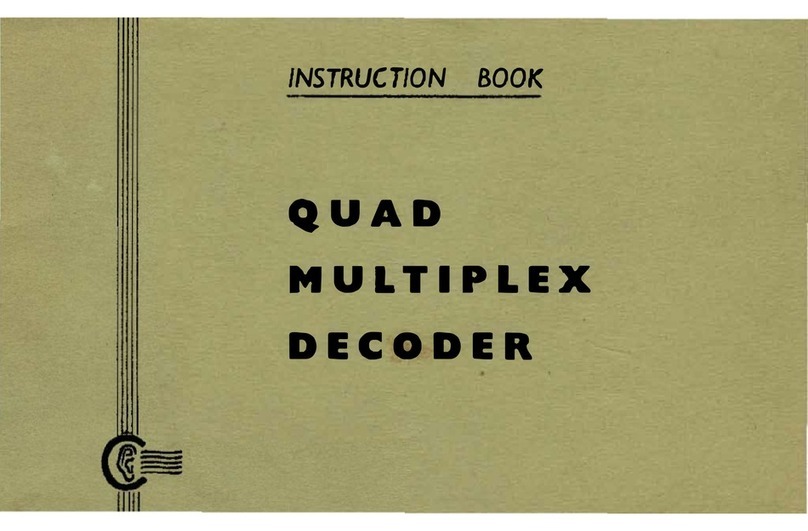
Acoustical Manufacturing Co.
Acoustical Manufacturing Co. QUAD MULTIPLEX DECODER Instruction book
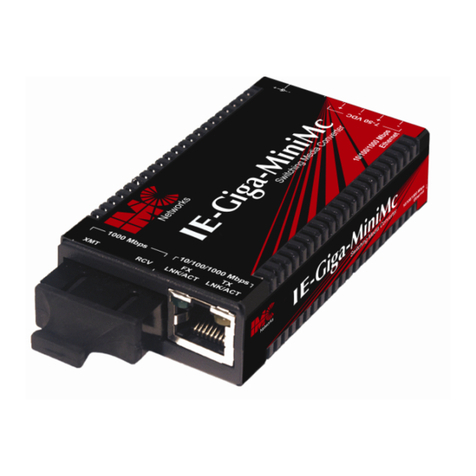
IMC Networks
IMC Networks IE-Giga-MiniMc Operation manual

Schiit
Schiit FULLA 4 manual

Irenis
Irenis BLANKOM HDE-275 Quick start manual

Canadian Power Conversion
Canadian Power Conversion CPC-20 owner's manual
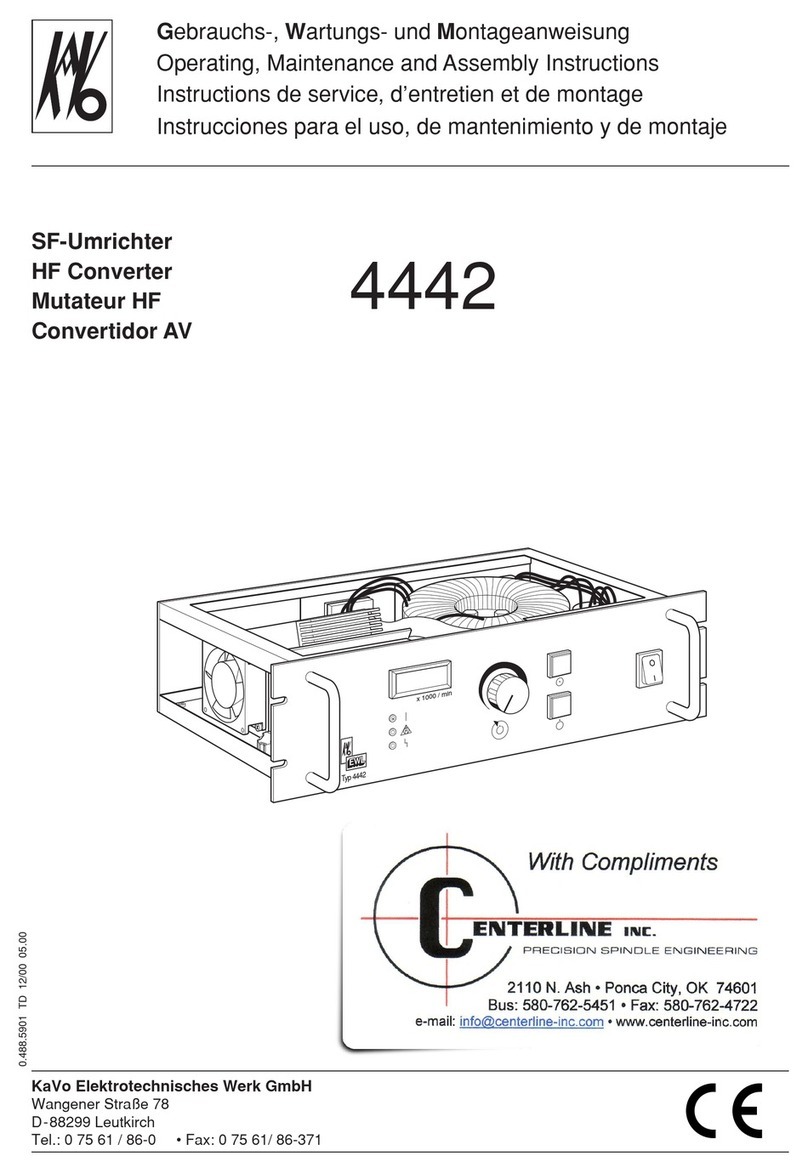
KaVo
KaVo EWL 4442 Operating, Maintenance and Assembly Instructions

Avenview
Avenview 3G/HD/SD-SDI to HDMI Converter user guide

ICT
ICT ISOLATED 2 Series instruction manual
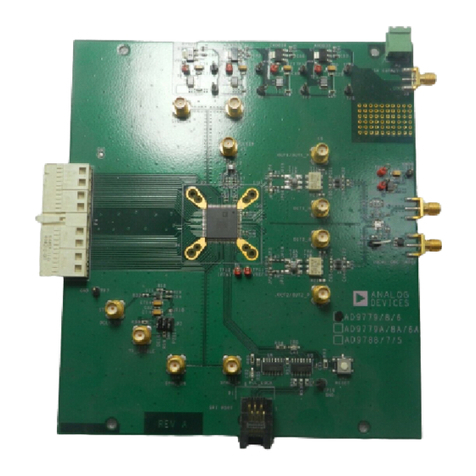
Analog Devices
Analog Devices AD9779 Preliminary Technical Data
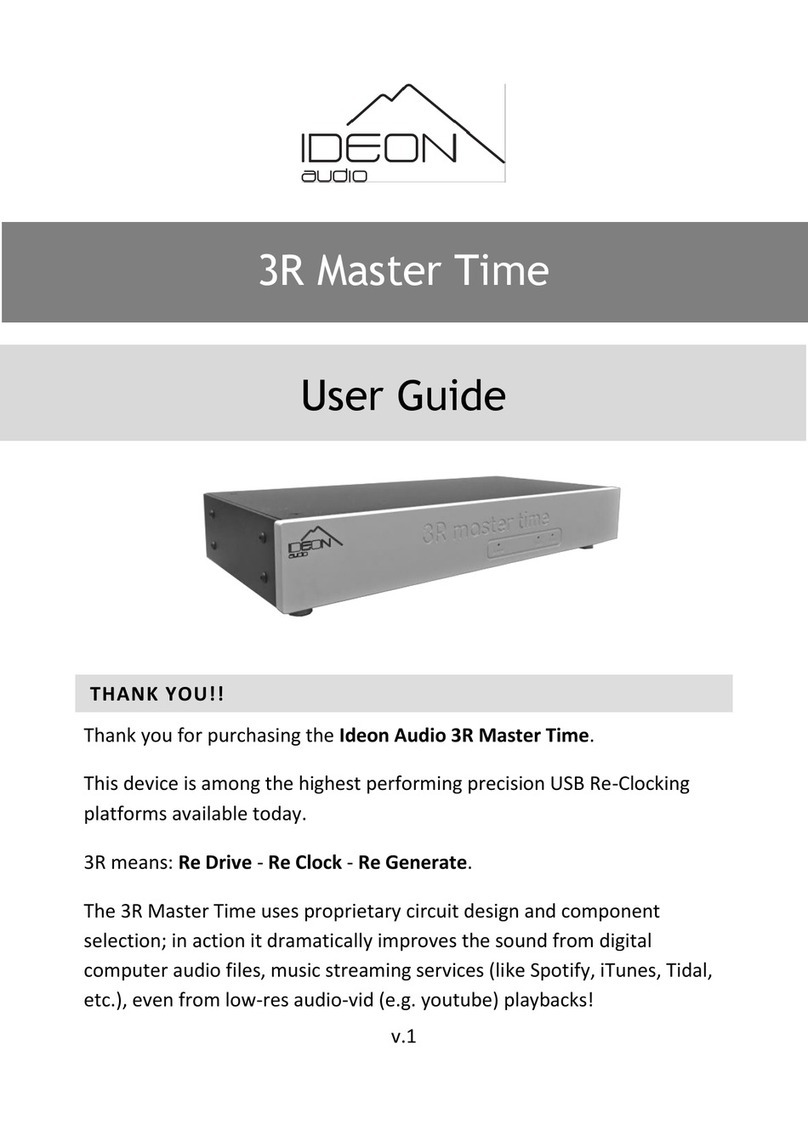
Ideon Audio
Ideon Audio 3R Master Time user guide
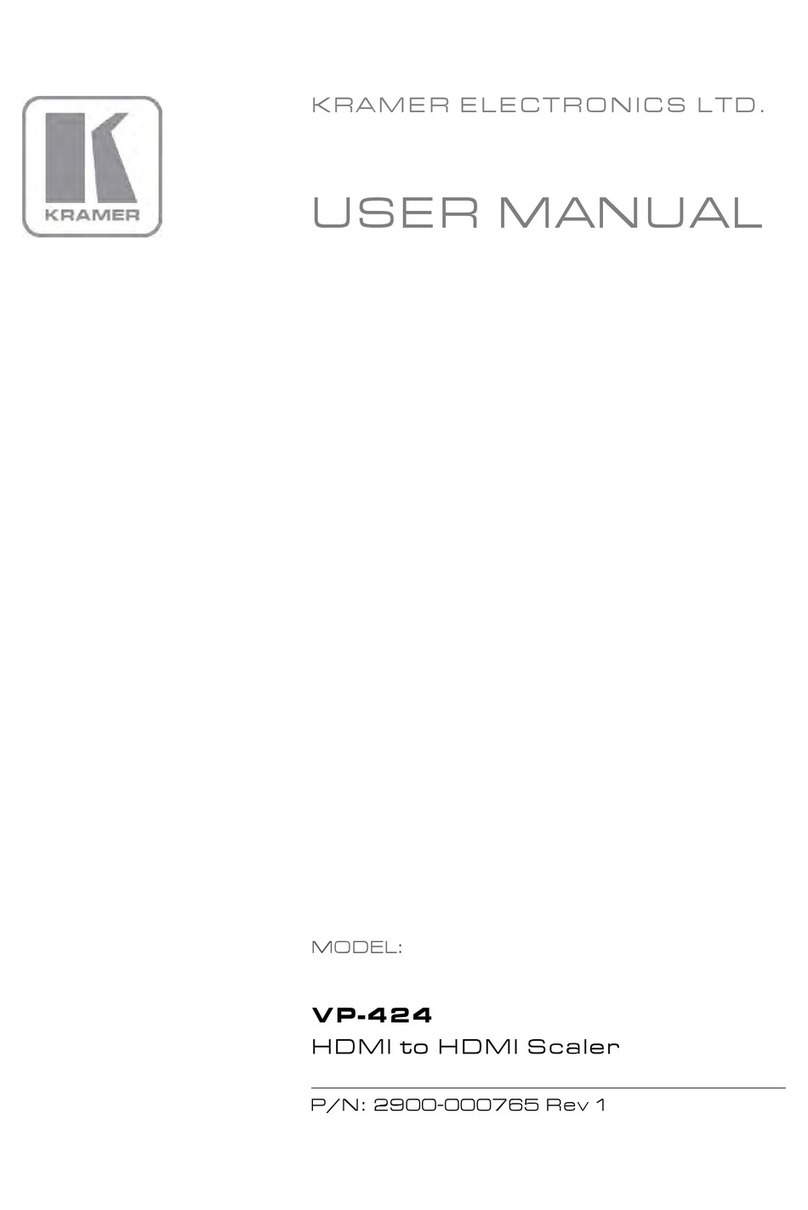
Kramer
Kramer VP-424 user manual

